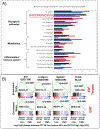Multi-omics Integration Analysis Robustly Predicts High-Grade Patient Survival and Identifies CPT1B Effect on Fatty Acid Metabolism in Bladder Cancer
- PMID: 30846479
- PMCID: PMC6571061
- DOI: 10.1158/1078-0432.CCR-18-1515
Multi-omics Integration Analysis Robustly Predicts High-Grade Patient Survival and Identifies CPT1B Effect on Fatty Acid Metabolism in Bladder Cancer
Abstract
Purpose: The perturbation of metabolic pathways in high-grade bladder cancer has not been investigated. We aimed to identify a metabolic signature in high-grade bladder cancer by integrating unbiased metabolomics, lipidomics, and transcriptomics to predict patient survival and to discover novel therapeutic targets.
Experimental design: We performed high-resolution liquid chromatography mass spectrometry (LC-MS) and bioinformatic analysis to determine the global metabolome and lipidome in high-grade bladder cancer. We further investigated the effects of impaired metabolic pathways using in vitro and in vivo models.
Results: We identified 519 differential metabolites and 19 lipids that were differentially expressed between low-grade and high-grade bladder cancer using the NIST MS metabolomics compendium and lipidblast MS/MS libraries, respectively. Pathway analysis revealed a unique set of biochemical pathways that are highly deregulated in high-grade bladder cancer. Integromics analysis identified a molecular gene signature associated with poor patient survival in bladder cancer. Low expression of CPT1B in high-grade tumors was associated with low FAO and low acyl carnitine levels in high-grade bladder cancer, which were confirmed using tissue microarrays. Ectopic expression of the CPT1B in high-grade bladder cancer cells led to reduced EMT in in vitro, and reduced cell proliferation, EMT, and metastasis in vivo.
Conclusions: Our study demonstrates a novel approach for the integration of metabolomics, lipidomics, and transcriptomics data, and identifies a common gene signature associated with poor survival in patients with bladder cancer. Our data also suggest that impairment of FAO due to downregulation of CPT1B plays an important role in the progression toward high-grade bladder cancer and provide potential targets for therapeutic intervention.
©2019 American Association for Cancer Research.
Conflict of interest statement
Figures






References
-
- Siegel RL, Miller KD & Jemal A Cancer Statistics, 2017. CA Cancer J Clin 67, 7–30 (2017). - PubMed
-
- Ettinger DS, et al. Non-Small Cell Lung Cancer, Version 6.2015. J Natl Compr Canc Netw 13, 515–524 (2015). - PubMed
-
- Gradishar WJ, et al. Breast Cancer Version 2.2015. J Natl Compr Canc Netw 13, 448–475 (2015). - PubMed
Publication types
MeSH terms
Substances
Grants and funding
LinkOut - more resources
Full Text Sources
Medical

